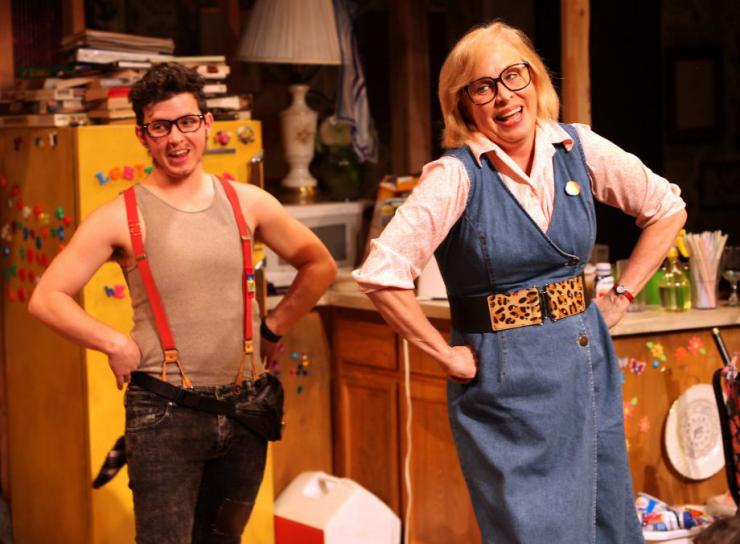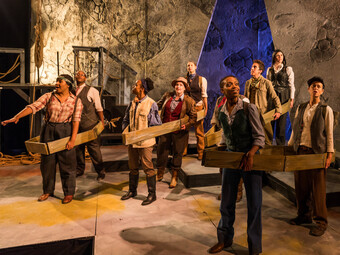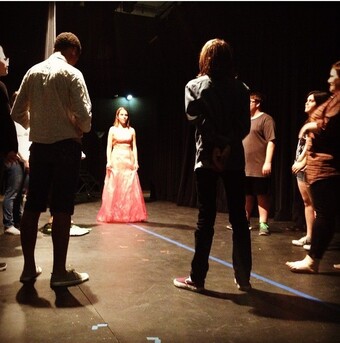Believably Trans
Who Counts as Trans Onstage?
This series will explore questions of gender, power, and politics in the work we are making, how we are making it, and how it is received.
In a theatre class I teach I introduce my students to the work of Bertolt Brecht. Because many of them are performers I spend a good amount of time on Brecht’s thoughts about acting. My students are very interested in Brecht’s idea of a “double role,” the idea that the actor is not playing the character but showing the audience the character, the idea that the audience should see the actor and the character at the same time. In A Short Organum on Theatre, he states:
At no moment must he go so far as to be wholly transformed into the character played. The verdict: “he didn’t act Lear, he was Lear” would be an annihilating blow to him.
The audience should have a keen awareness that they are seeing the actor’s interpretation of a character, a presentation of the phenomenon of Lear. Brecht even encouraged casting across gender to achieve this performance style.
The double role works because an audience watches theatre in a unique way. The audience of a movie set in Victorian England is looking for proof—they want to see the streets, the houses, the clothing, the accents. But in the theatre, an actor can simply hold up a sign that says, “Victorian England,” and the audience will suspend disbelief. I, for one, enjoy a performance that acknowledges the distance between our world and the play-world over one that asks us to collapse our worlds completely. So in fact as theatre artists we know our audience will go with us on huge jumps of suspending disbelief, and, most likely, enjoy them. But still I find lack of buy-in around the idea of a double role, particularly where trans characters come in. I see artists focused much more exclusively on who can believably “pass” as trans. For a cisgender audience.
I think about how this question has impacted the idea of “color-blind” casting, which is language I struggle with. I feel uncomfortable with the assertion that we are aiming for “blindness,” 1) because it has problematic ableist connotations, and 2) because we should not be turning a blind eye to the power dynamics of race when casting. Our choices have implications and we should be acknowledging and considering those, not pretending we do not see them. Could we say “color-conscious,” instead? I think that, very occasionally and slowly, we’ve started to learn how rich and vast our opportunities are for disregarding this realist style of collapsing character and actor where race is concerned. We’ve started to see how, in fact, casting actors of color as founding fathers of American history in Hamilton, can keep us deeply aware of the theatricality, history, and craft in a performance.
How can we push the creative languages we are working with away from realism in order to acknowledge and celebrate the bodies we want to see onstage? Investing in the double-ness of character and actor can work not only to ease casting woes but to generate exciting theatre.
What makes a trans character credible onstage? Sometimes I hear from folks looking to cast a trans actor who the audience can clearly identify as their assigned sex. Sometimes I hear from folks whose casting criteria is an actor that can provide gender ambiguity. Rarely do I hear anyone looking to cast an actor who is trans but whose “trans-ness” won’t be obvious to the audience. But in real life many trans humans’ trans-ness is not obvious. At least not in the way many theatregoing folks might imagine. I fear this need to collapse trans character with trans actor arises from a combination of few reference points or imagination around what a trans-person can look like and lack of trust in the audience. But what if we moved beyond this? What if we invited audiences to see a trans actor as trans, whether or not the actor conforms to their assumptions of what a trans-person looks like?

Embracing the double role provides an exciting opportunity to wed our creative choices to progressive labor politics. If, suddenly, a character written as a white straight man does not need to be cast as a white straight man because we trust the audience enough to suspend disbelief, how might we cast that role in a way that considers who is typically cast and who is not? How can we push the creative languages we are working with away from realism in order to acknowledge and celebrate the bodies we want to see onstage? Investing in the double-ness of character and actor can work not only to ease casting woes but to generate exciting theatre.
Conscious casting where trans people are concerned is actually education. We have an opportunity to teach an audience to see trans-people not as near cis-people or people in a process of becoming cisgender but as people exactly as we are, people who may never conform to the binary gender system. Do this for characters that are specifically trans and characters that are not. Do this in a way that acknowledges whose stories you are used to seeing and whose stories you aren’t, what bodies are acceptable/familiar, and what bodies aren’t. Our work is choosing what is visible, so let’s make our choices count.









Comments
The article is just the start of the conversation—we want to know what you think about this subject, too! HowlRound is a space for knowledge-sharing, and we welcome spirited, thoughtful, and on-topic dialogue. Find our full comments policy here
Again, we are stuck with the problem of verisimilitude: what does it mean to be "exactly as we are"? what if a trans person appears as cis onstage (whatever this means)? Do all trans bodies come off in exactly the same way? Are we watching a narrative or the empirical fact of a body? Are the literal bodies what give a play its authenticity or imprimateur? Arcade Fire's WE EXIST video caught a lot of flak for using Andrew Garfield as the gender nonconforming protagonist. I thought the video was illuminating, deeply moving and great. Do we need to know the gender status of an actor in order for that actor to convey meaning and authenticity? I think this is a problematic and complicated area. In any case, thank you for this essay and generating thought and conversation.
hey there,
thanks for this comment. the territory is certainly tricky and you bring up a lot of great questions. certainly there are many cases with no clear "right" answers about who to cast and in many cases the creative integrity of a piece may appear to be at odds with the "identity" integrity of casting choices, but this is where I think conscious casting comes in. we can't turn a blind eye to the bodies in front of us-- doing so would be to pretend we actually don't see difference and we do. so we need to build our creative languages around the bodies we want to see onstage. I agree that authenticity isn't possible, but I do think justice is.
mjk
Hey MJ,
I love this call to action and the breakdown of Brecht's "double roll" concept (something that is very dear to my heart) and how purposeful it can be when applying it to casting trans performers. I also want to point out, in case you or Polly (I'm assuming Polly was the editor) don't know, that the photo you included from my play "Hir" represents the only play of mine that actually needs a transmasculine performer to appear transmasculine (at least in the first act). There are a plethora of production photos of trans and genderqueer performers performing in my plays over the years; photos of them playing characters who are cisgender, transgender, and even characters whose genders aren't part of the conversation of the play. I'd love to send you one of the immensely talented, Bianca Leigh, in my play "Red Tide Blooming" or of the mad genius Glenn Marla in "The Lily's Revenge", or even one of me performing the "double roll" in Brecht's "Good Person of Szechwan". Obviously my work shouldn't represent the entire history of trans casting so, if imagery is something you’re interested in including in the article, I’d also recommend you reach out to others who have a history of working with trans performers. Let me know if you need a list (I'm guessing you know who they are) as it’s fun to acknowledge the people who, though on the fringe, have been doing exactly what your calling out for more of. I hope this comment comes across to be one of clarity, excitement, and appreciation, because that is its intention.
Xo
Taylor Mac
Hi Taylor,
thank you so much for this response!! we would absolutely LOVE more photos of your work to include in this series! I'm not so used to visual story-telling and hadn't yet realized the potential for captions to illustrate the connection between the photo and the article, or for discussing the photo in the article- but I completely understand about Hir being a rare moment in your career. I did choose the photo to illustrate a more realism-based casting approach for trans characters and thoroughly recognize this as not typical in your work. one thing I was hoping to say with the article is that embracing the double role doesn't mean that a trans role could be cast with a cis actor, but rather that there is great diversity of trans performers and we don't have to cast based on who "passes" as trans to a cis-audience. I still think trans characters should be cast with trans actors. but you definitely know that- just wanted to clarify for anyone reading who might be confused. we'd love to include more photos and writing by you in this series! let's discuss more over email.
thanks for this great comment,
mjk
You both make my head hurt.